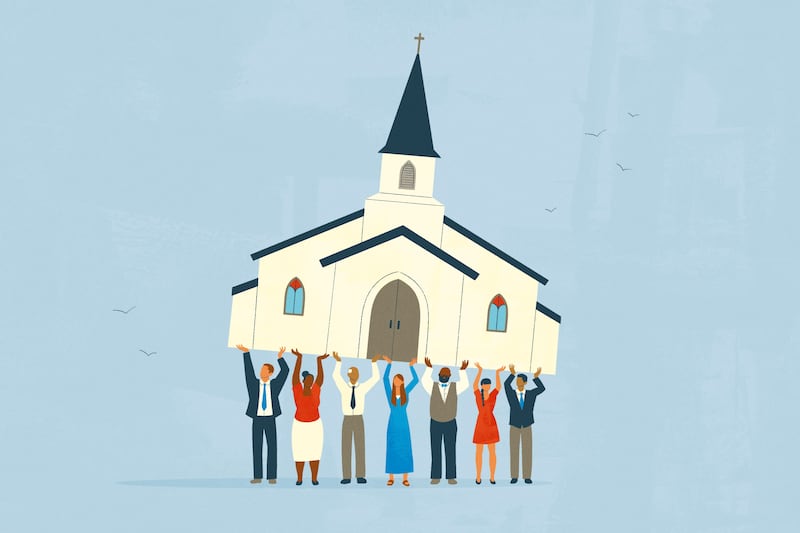The question of “who is Christian” stretches back to Christianity’s first communities: Could non-Jews become real Christians?
The question of identity has roiled Christians ever since. The European bloodletting over legitimacy and Christian belonging was so intense after the Protestant Reformation that the American project itself can be seen in part as a political answer to the desperate problem of Christian identity.
After the stunned silence that follows religious violence, questions about politics, faith and boundaries become more urgent. Latter-day Saints’ own history with these category debates is also relevant. Initially, the combination of the Saints’ efforts to distinguish themselves, their neighbors’ responses and the ensuing tensions made for some very hard lines.
The violence over those same lines amount to genuine American tragedies. Characteristically, the early Saints’ most famous poet despaired over dashed dreams of harmony and religious freedom. In Eliza R. Snow’s poem, “Let Us Go,” penned as her people made their way toward a new homeland as refugees, she viscerally described what two decades of conflict had spawned. “Let us go, let us go to the far western shore, Where the bloodthirsty ‘Christians’ will hunt us no more.”
The bloodshed largely dissipated over the 19th century, but the tensions over the label remained. And they were even given new life in the 20th century.
Conservative American Protestants, defensive in the face of changing times at the century’s start, drew tight theological boundaries around “true” Christianity over and against “modernizing” figures within their own churches. They also targeted the outsiders whom they’d long found theologically subversive, including Roman Catholics and Latter-day Saints.
While the modernists grew less concerned about policing who was or wasn’t Christian, conservatives grew seemingly more so. Especially, it turns out, along the “fundamentalist” edge of the Conservative Protestant spectrum.
Given the nickname by an influential book series, “The Fundamentals” (1910), these sorts of Protestants shared much theologically with their Evangelical ecclesiastical cousins. The difference? Temperament.
In a famous description from renowned historian George Marsden, a fundamentalist is “an evangelical who is angry at something.” These Protestants also worried over the end times and obsessed about the identity of the biblical “anti-Christ” who was to appear during the earth’s winding-up scenes. They mapped their biblical imaginations onto world events and cast various figures or institutions as the anti-Christ, from Mussolini to the U.S.S.R.
As Latter-day Saints made stronger claims to Christian identity in the face of fundamentalist and evangelical objections by mid-century, both sides frequently talked past one another.
The Saints generally came to regard the label “Christian” in sociological terms: if you try to follow Jesus, you are a Christian. Conservative Protestants tended to stick to more formal, historical and theological definitions, which the Saints only half-conformed to, at best. Roman Catholics, Eastern Orthodox, Coptic Christians, etc., construed these categories in their own ways but often weren’t quite sure what to make of their Latter-day Saint neighbors, either.
For our part, Latter-day Saints have sometimes said ungenerous, misinformed or dismissive things about other Christians, too.
Importantly, the various groups so often use the same terms and read from the same biblical passages, but they can agree heartily or wildly disagree on theological particulars depending on the topic under consideration.
Over the past generation, things have started to change. Neighbors have pushed beyond stereotypes to find meaningful commonalities across religious divides. Ecclesiastical leaders have joined in common cause across church and political boundaries.
On our academic side, starting in the 1990s, scholars from varied Christian streams began talking and writing together. Their work helped turn the temperature down and clarify points of agreement and distinction. For 20 years, I was witness to extraordinary gatherings of this sort, where friendship and genuine understanding displaced decades of ill-will and misunderstanding.
More recently, I have seen at close range a possible next step in the evolving relationship between Latter-day Saints and wider Christianity. Over the past five years, I have worked with scholars from varied traditions thinking together about “Christology,” the technical term for the branch of academic theology that takes up the questions of Christ’s nature and being.
Our goal has not been to simply understand each other’s perspectives, and we are largely uninterested in the by-now well-worn question of Latter-day Saints being real Christians or not.
We have had a more fundamental aim in mind, taken from Latter-day Saint scripture. We have endeavored to “seek this Jesus,” together (Ether 12:41).
That is, we have wondered what we can learn from each other in our disciplined practice of Christian faith. What habits of mind, what questions, and what resources of yours might enrich our tradition?
Our culminating gathering at Oxford, England, last year felt like a glimpse into a possible future, where Christians of varied backgrounds (Anglican, Methodist, Roman Catholic, Latter-day Saint) had built the kinds of relationships that could bear the weight of hard questions while opening new insights in process.
This was made possible to a large degree by an Anglican priest and theologian, Rev. Dr. Andrew Teal, who has dedicated much of the last decade to facilitating rich collaborations of mind and spirit with Latter-day Saints. In his opening remarks to that Oxford gathering, he noted that in Christ’s famous question in Matthew 16 — “Whom say ye that I am?” — the original Greek for “ye” is plural.
In other words, all of us who claim to follow him should be answering together. Even in our distinctiveness and differences, Christian discipleship is best pursued together. It’s the kind of future all Christians should hope to build.
J. Spencer Fluhman’s opinions are his own and do not represent official statements of the History Department, Brigham Young University, or The Church of Jesus Christ of Latter-day Saints.


